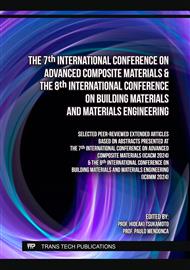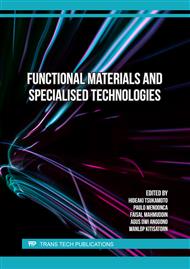[1]
Wang, F. J., Zhao, M., Yan, J. B., Qiu, S., Liu, X., & Zhang, B. Y. (2020). Investigation of Damage Reduction When Dry-Drilling Aramid Fiber-Reinforced Plastics Based on a Three-Point Step Drill. Materials, 13(23), 5457.
DOI: 10.3390/ma13235457
Google Scholar
[2]
Karim, M. A., Abdullah, M. Z., Deifalla, A. F., Azab, M., & Waqar, A. (2023). An assessment of the processing parameters and application of fibre-reinforced polymers (FRPs) in the petroleum and natural gas industries: A review. Results in Engineering, 101091.
DOI: 10.1016/j.rineng.2023.101091
Google Scholar
[3]
Aamir, M., Giasin, K., Tolouei-Rad, M., & Vafadar, A. (2020). A review: Drilling performance and hole quality of aluminium alloys for aerospace applications. Journal of Materials Research and Technology, 9(6), 12484-12500.
DOI: 10.1016/j.jmrt.2020.09.003
Google Scholar
[4]
Kundu, S., Das, S., & Saha, P. P. (2014). Optimization of drilling parameters to minimize burr by providing back-up support on aluminium alloy. Procedia Engineering, 97, 230-240.
DOI: 10.1016/j.proeng.2014.12.246
Google Scholar
[5]
Dornfeld, D., & Min, S. (2010). A review of burr formation in machining. In Burrs-Analysis, Control and Removal: Proceedings of the CIRP International Conference on Burrs, 2nd-3rd April, 2009, University of Kaiserslautern, Germany (pp.3-11). Springer Berlin Heidelberg.
DOI: 10.1007/978-3-642-00568-8_1
Google Scholar
[6]
Liu S, Xia W, Wang N, Song Y, Luo B, Zhang K. (2020). Multi-objective drilling parameters optimization method for CFRP/Ti stacks. Journal of Mechanical Engineering, 56(7), 193-203.
DOI: 10.3901/jme.2020.07.193
Google Scholar
[7]
Pardo, A., Heinemann, R., & Chen, C. C. (2021). The effect of cutting parameter changeover position on interface borehole quality in drilling of aerospace CFRP/Al stacks. Procedia CIRP, 101, 314-317.
DOI: 10.1016/j.procir.2020.11.014
Google Scholar
[8]
Zhang, X., Li, M., & Huang, D. (2023). Surface quality and burr characterization during drilling CFRP/Al stacks with acoustic emission monitoring. Journal of Manufacturing Processes, 98, 138-148.
DOI: 10.1016/j.jmapro.2023.04.076
Google Scholar
[9]
Coromant, S. (2010). Users guide-machining carbon fibre materials. AB Sandvik Coromant Website. (Accessed March 2012). URL http://www2. coromant. sandvik. com/coromant/downloads/users_guide/eng/C-2920-30. pdf.
DOI: 10.51257/a-v1-bm7088
Google Scholar
[10]
Zhao, M., Wang, F., Fu, R., Sun, K., Du, C., & Cui, J. (2023). Drilling study on CFRP/Al stack with different CFRP thickness using chip-breaking step drill bit. Journal of Manufacturing Processes, 90, 300-309.
DOI: 10.1016/j.jmapro.2023.01.050
Google Scholar
[11]
Hassan, M. H., Abdullah, J., Franz, G., Shen, C. Y., & Mahmoodian, R. (2021). Effect of twist drill geometry and drilling parameters on hole quality in single-shot drilling of CFRP/Al7075-T6 Composite Stack. Journal of Composites Science, 5(7), 189.
DOI: 10.3390/jcs5070189
Google Scholar
[12]
Oueslati, H., Jain, J. R., Reckmann, H., Ledgerwood III, L. W., Pessier, R., & Chandrasekaran, S. (2013, September). New insights into drilling dynamics through high-frequency vibration measurement and modeling. In SPE Annual Technical Conference and Exhibition? (p. D031S042R001). SPE.
DOI: 10.2118/166212-ms
Google Scholar
[13]
Kurfess, T. R. (2017). Precision manufacturing. In The Mechanical Systems Design Handbook (pp.151-179). CRC Press.
Google Scholar
[14]
Hassan, M., Abdullah, J., Mahmud, A. S., & Supran, A. (2018). Effects of twist drill geometry and drilling parameters on CFRP aluminum stack up in single shot drilling. SciFed Mater Res Lett, 2(2).
DOI: 10.3390/jcs5070189
Google Scholar
[15]
Nouari, M., List, G., Girot, F., & Coupard, D. (2003). Experimental analysis and optimisation of tool wear in dry machining of aluminium alloys. Wear, 255(7-12), 1359-1368.
DOI: 10.1016/s0043-1648(03)00105-4
Google Scholar
[16]
Rimpault, X., Chatelain, J. F., Klemberg-Sapieha, J. E., & Balazinski, M. (2017). Burr height monitoring while drilling CFRP/titanium/aluminium stacks. Mechanics & Industry, 18(1), 114.
DOI: 10.1051/meca/2015073
Google Scholar
[17]
Sreenivasulu, R., Rao, C., & Ravindra, K. (2020). Effect of thrust and torque exerted during drilling to optimize exit burr height and thickness by choosing variable drill bit geometry: A simplified theoretical model approach. International Journal of Data and Network Science, 4(1), 43-56.
DOI: 10.5267/j.ijdns.2019.8.003
Google Scholar



